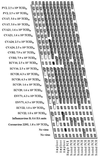Multicenter quality assessment of PCR methods for detection of enteroviruses
- PMID: 10203496
- PMCID: PMC84788
- DOI: 10.1128/JCM.37.5.1409-1414.1999
Multicenter quality assessment of PCR methods for detection of enteroviruses
Abstract
We conducted a multicenter evaluation of commercial and in-house PCR methods for the detection of enteroviruses. Three coded panels of test and control RNA samples, artificial clinical specimens, and representative enterovirus serotypes were used to assess amplification methods, RNA extraction methods, and reactivities with different enterovirus serotypes. Despite several differences between PCR methods, there was good agreement, although some variation in sensitivity was observed. Most PCR methods were able to detect enterovirus RNA derived from 0.01 50% tissue culture infective dose (TCID50) and were able to detect at least 1 TCID50 of enterovirus in cerebrospinal fluid, stool, or throat swab specimens. Most were also able to detect a wide range of enterovirus serotypes, although serotypic identification was not possible. Some laboratories experienced false-positive results due to PCR contamination, which appeared to result mainly from cross-contamination of specimens during RNA extraction. Provided that this problem is overcome, these PCR methods will prove to be a sensitive and rapid alternative to cell culture for the diagnosis of enterovirus infection.
Figures



References
-
- Abraham R, Chonmaitree T, McCombs J, Prabhakar B, Lo Verde P T, Ogra P L. Rapid detection of poliovirus by reverse transcription and polymerase chain reaction amplification: application for differentiation between poliovirus and nonpoliovirus enteroviruses. J Clin Microbiol. 1993;31:395–399. - PMC - PubMed
-
- Abzug M J, Loeffelholz M, Rotbart H A. Diagnosis of neonatal enterovirus infection by polymerase chain reaction. J Pediatr. 1995;126:447–450. - PubMed
-
- Andréoletti L, Blassel-Damman N, Dewilde A, Vallée L, Cremer R, Hober D, Wattré P. Comparison of use of cerebrospinal fluid, serum, and throat swab specimens in diagnosis of enteroviral acute neurological infection by a rapid RNA detection PCR assay. J Clin Microbiol. 1998;36:589–591. - PMC - PubMed
-
- Balanant J, Guillot S, Candrea A, Delpeyroux F, Crainic R. The natural genomic variability of polioviruses analysed by a restriction fragment length polymorphism assay. Virology. 1991;184:645–654. - PubMed
Publication types
MeSH terms
Substances
Associated data
- Actions
- Actions
- Actions
- Actions
- Actions
- Actions
- Actions
- Actions
- Actions
LinkOut - more resources
Full Text Sources

